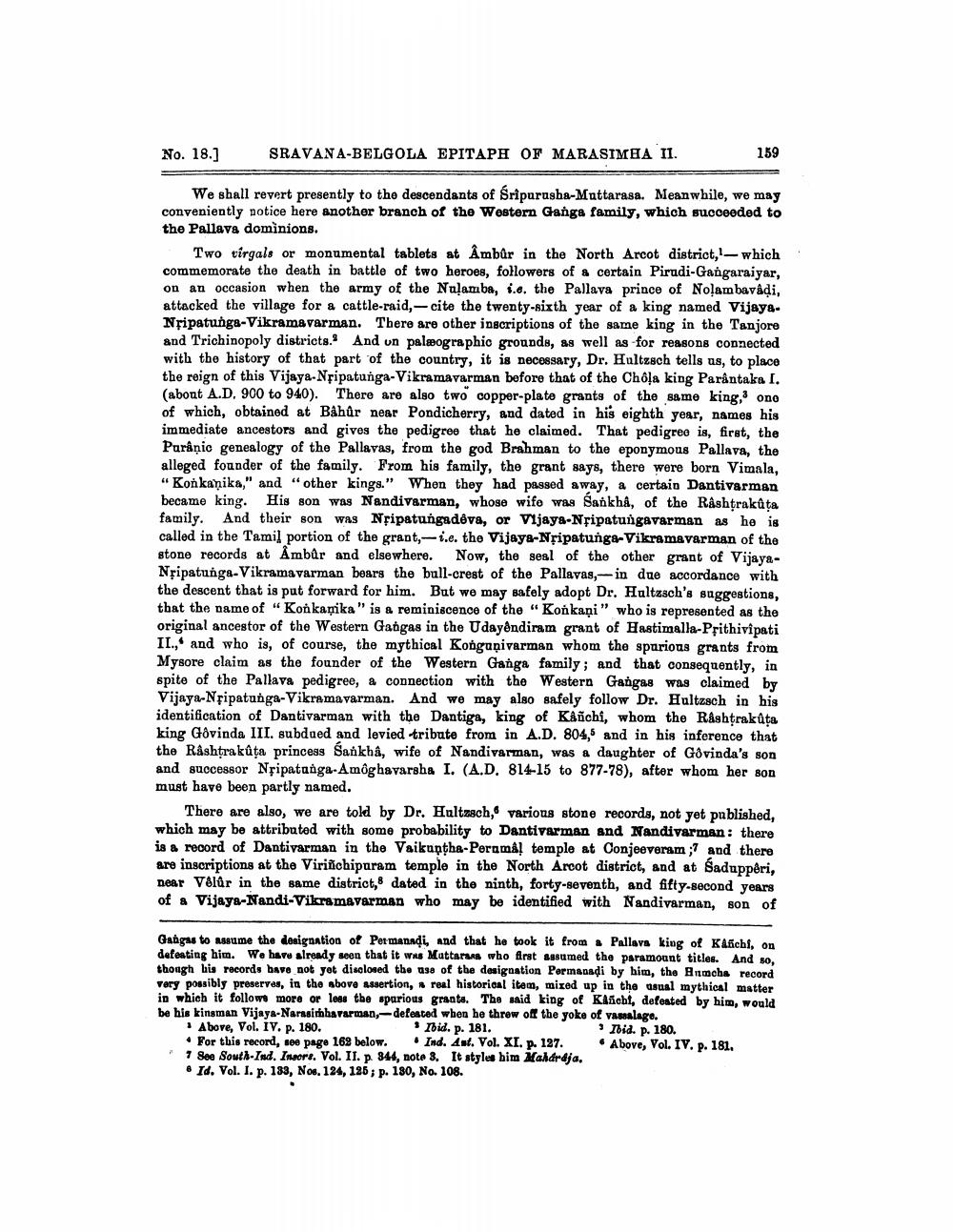________________
No. 18.]
SRAVANA-BELGOLA EPITAPH OF MARASIMHA II.
159
We shall revert presently to the descendants of Sripurusha-Mattarasa. Meanwhile, we may conveniently notice here another branch of the Western Ganga family, which succeeded to the Pallava domìnions.
Two virgals or monumental tablets at Âmbůr in the North Arcot district, which commemorate the death in battle of two heroes, followers of a certain Pirudi-Gangaraiyar, on an occasion when the army of the Nalamba, i.e. the Pallava prince of Noļambavadi, attacked the village for a cattle-raid, - cite the twenty-sixth year of a king named Vijaya. Nřipatunga-Vikramavarman. There are other inscriptions of the same king in the Tanjore and Trichinopoly districts. And un palæographic grounds, as well as for reasons connected with the history of that part of the country, it is necessary, Dr. Hultzsch tells us, to place the reign of this Vijaya-Nțipatunga-Vikramavarman before that of the Chola king Parântaka I. (about A.D. 900 to 940). There are also two copper-plate grants of the same king, one of which, obtained at Bahûr near Pondicherry, and dated in his eighth year, names his immediate ancestors and gives the pedigree that he claimed. That pedigreo is, first, the Parâņic genealogy of the Pallavas, from the god Brahman to the eponymous Pallava, the alleged founder of the family. From his family, the grant says, there were born Vimala, "Konkanika," and "other kings." When they had passed away, a certain Dantivarman became king. His son was Nandivarman, whose wife was Sankhå, of the Rashtrakûta family. And their son was Nřipatungadêva, or Vijaya-Nfipatungavarman as he is called in the Tamil portion of the grant,-i.e. the Vijaya-Nripatunge-Vikramavarman of the stone records at Åmbûr and elsewhere. Now, the seal of the other grant of VijayaNřipatunga-Vikramavarman bears the bull-crest of the Pallavas,- in due accordance with the descent that is put forward for him. But we may safely adopt Dr. Haltzsch's suggestions, that the name of "Konkanika" is a reminiscence of the "Konkaņi" who is represented as the original ancestor of the Western Gangas in the Udayêndiram grant of Hastimalla-Pfithivipati II.,' and who is, of course, the mythical Konguộivarman whom the spurious grants from Mysore claim as the founder of the Western Ganga family; and that consequently, in spite of the Pallava pedigree, & connection with the Western Gangas was claimed by Vijaya-Nțipatunga-Vikramavarman. And we may also safely follow Dr. Haltzsch in his identification of Dantivarman with the Dantiga, king of Kanchi, whom the Rashtrakůta king Govinda III. subdued and levied tribute from in A.D. 804,5 and in his inference that the Râshtra kůta princess Sankha, wife of Nandivarman, was a daughter of Govinda's son and successor Nripatanga-Amoghavarsha I. (A.D. 814-15 to 877-78), after whom her son must have been partly named.
There are also, we are told by Dr. Hultzsch, various stone records, not yet published, which may be attributed with some probability to Dantivarman and Nandivarman: there is & record of Dantivarman in the Vaikuntha-Perama! temple at Conjeeveram ;and there are inscriptions at the Virinchipuram temple in the North Arcot district, and at Sadupperi, near Vélûr in the same district, dated in the ninth, forty-seventh, and fifty-second years of a Vijaya-Nandi-Vikramavarman who may be identified with Nandivarman, son of
Gangas to assume the designation of Permanadi, and that he took it from Pallava king of Kitchf, on defeating him. We have already seen that it was Mattaras who first assumed the paramount titles. And so, though his records bave not yet disclosed the use of the desigastion Permaosdi by him, the Anmcha record very possibly preserves, in the above assertion, real historical item, mixed up in the usual mythical matter in which it follow more or less the sparious grants. The said king of Kaichi, defeated by him, would be his kingman Vijaya-Narasimhararman,-defeated when he threw of the yoke of vasalage. Above, Vol. IV. p. 180.
Ibid. p. 181.
Ibid. p. 180. • For this record, see page 169 below. Ind. Ant. Vol. XI. p. 137. Above, Vol. IV. p. 181. 7 See South-Ind. Incore. Vol. II. p. 344, note 3. It styles bim Haldrdja. & Id. Vol. I. p. 183, Nos. 124, 125, p. 180, No. 108.




